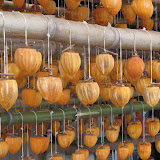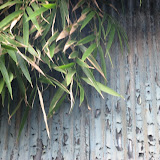Yamanashi Prefecture Two-Day Getaway

This is the home of the famous Samurai, Takeda, and family. It was truly one of the best temples I've ever been to. Plus, we got to walk around most of the house which is very rare. This is the backyard. I can't imagine that it's more beautiful any other season.

Here's a glimpse of the gorgeous colors that Yumi and I saw all over the prefecture. There were many red and yellow maple trees plus splashes of color on the only three trees bearing fruit: Quince, Apple and Persimmon.

This place was my
favorite thing that we saw in two days. This temple was amazing. The garden was laid out perfectly. Despite the season, it was still gorgeous.

I always think these things are so cool and mean to take photos of them to share with you guys. Anyway, this is a "drain" that guides the rain water from the roof to the ground. It's really pretty to watch the water trickle down and I wonder why traditional homes opt for this instead of an ugly pipe...

Finally! A true Japanese breakfast! I enjoyed: sweet potato, baby okra, lotus root, two types of seaweed, various root vegetables,
nato (fermented beans,) salted cabbage,
miso soup, sweet red bean, white rice and green tea for my breakfast at the resort.
Last night, we soaked in a mineral bath on the balcony overlooking the valley. It was really, really cool and liberating. I felt like a Japanese lady in a woodblock work of art.

This is the view from the door of our room. To the left is the bathroom, to the right, the shoe rack and straight ahead the living area. It's full tatami or straw matt floors. We slept on futons, and hung out and went to the onsen (community baths,) in our yukata (informal kimonos.) Thee only thing in the room was a low coffee table, a few cushions and a tv. We watched some Angelina Jolie (the only thing in English so I could comprehend,) movie before passing out after a French-inspired meal that burst our guts.

Seriously. Beautiful. And this is November folks, NOVEMBER!


All over were strings of "
kaki," or persimmon as we Americans call it. According to Yumi (we'll have to believe what she says for we have no alternative,) there are several types of persimmon: while some are delicious off the branch, these are bitter. So, locals dry them and then they are enjoyed later when they are get a bit sweeter. We sampled some and although I didn't like them as a child, they are quite yummy to me now.

Did you think there wouldn't be a photo of me and sake?!?! Ha!
This sake holds the symbol (crest) of the Takeda family, one of the most famous samurai in Japanese history. So you see, I'm doing it for culture's sake...drinking the sake I mean.

"Houtou" This is the dish that the area is known for. It's a wonderful flour noodle hot-pot with veggies and meats including a local "
cabocha" vegetable that I think is like our acorn squash. Anyway, the squash, noodles, carrots, several Japanese mushrooms and green onion are cooked together with some chicken or pork plus the chubby, white udon noodles. You simply use a wooden ladle and chopsticks to dish some into a small bowl and then slurp and munch down.
So, so, SO GOOD!!!!
(Yamanashi Prefecture, Can't be More Specific Because Yumi Was in Charge and I Was Just Along for the Ride...)
 My folks came out a week ago and it's been a whirlwind of eating, toasting and sightseeing. We strolled down the street for awesome ramen and beer their first night in town. They opted for the chashumen, (pork and fried noodles,) and Matt and I had gomokuramen which is a ton of different meats and veggies with fried noodles. (Zushi, Japan)
My folks came out a week ago and it's been a whirlwind of eating, toasting and sightseeing. We strolled down the street for awesome ramen and beer their first night in town. They opted for the chashumen, (pork and fried noodles,) and Matt and I had gomokuramen which is a ton of different meats and veggies with fried noodles. (Zushi, Japan) We spent the night at our friends' restaurant in Kamakura. They are some of the nicest people we know and the shop always has good food, nice customers and great atmosphere. We ate and drank all night and they even had a beautiful cake with "happy birthday jessica chan" written on an edible white chocolate card! It was a great night and truly special. THANKS:) (Kamakura)
We spent the night at our friends' restaurant in Kamakura. They are some of the nicest people we know and the shop always has good food, nice customers and great atmosphere. We ate and drank all night and they even had a beautiful cake with "happy birthday jessica chan" written on an edible white chocolate card! It was a great night and truly special. THANKS:) (Kamakura)
 I'm pretty sure this has caught on already in the USA: You sit down to a table with a gas grill embedded in the middle controlled by a knob on the side of the table. Food comes at you raw, in bite-sized portions and you cook it and eat it right off the grill. We had all kinds of meat and veggies last night including this cut of chicken. It's a sliver of cartilage with some tasty white bits of meat. With only a little salt, it's moist, crunchy and DELICIOUS! (Kanazawa Hakeii)
I'm pretty sure this has caught on already in the USA: You sit down to a table with a gas grill embedded in the middle controlled by a knob on the side of the table. Food comes at you raw, in bite-sized portions and you cook it and eat it right off the grill. We had all kinds of meat and veggies last night including this cut of chicken. It's a sliver of cartilage with some tasty white bits of meat. With only a little salt, it's moist, crunchy and DELICIOUS! (Kanazawa Hakeii)











































